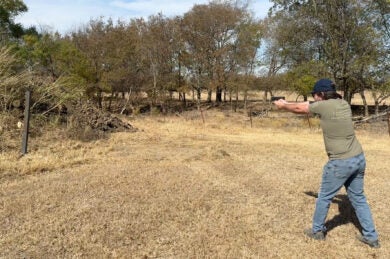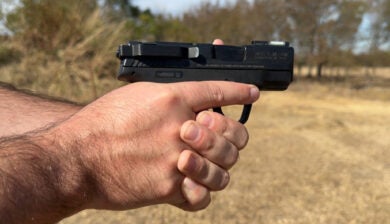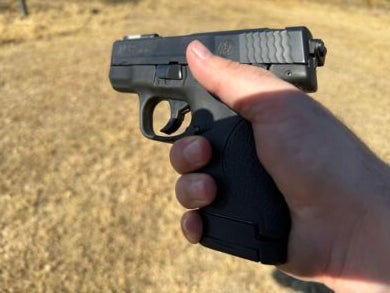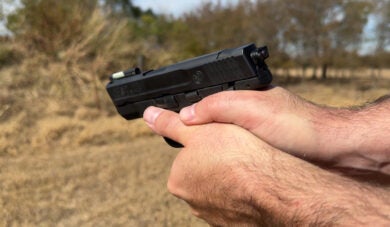How to Hold a Handgun: Tips, Tricks, and Common Mistakes to Avoid
Wes Littlefield 10.22.24
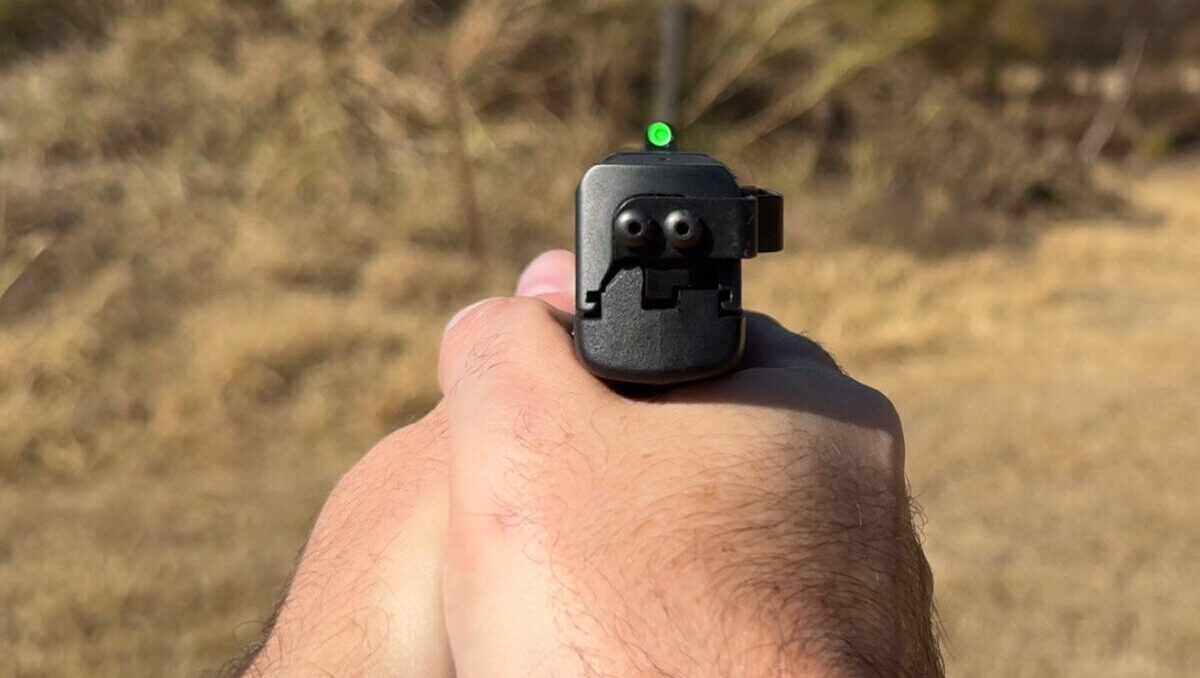
Growing up whitetail deer and duck hunting, I didn’t have much exposure to shooting a handgun. My grandfather would take me to the backside of his property and help me shoot some of his handguns and pistols, but that was all the instruction I received before taking my concealed carry permit course.
After getting my permit, I decided it was time to sharpen my skills and learn the proper techniques so I would not practice bad habits and poor technique. I enlisted the help of a buddy who served in the U.S. Army, U.S. Marines, and a law enforcement officer who runs a firearms training course. Here’s what I’ve picked up while shooting with professionals.
Stance
It all begins from the ground up. Just like athletics, you need to have a good stance. Start with your feet shoulder-width apart. I prefer a staggered stance, similar to a boxer, with whichever foot forward is more comfortable for you.
As a right-handed shooter, I prefer to have my left foot forward. Now, slightly bend your knees and ensure you’re on the balls of your feet. Standing flat-footed or resting on your heels will ensure you get knocked off balance by the recoil.
The last part of a good stance is rolling your shoulders and leaning forward with your arms straight. Some shooters like their elbows slightly bent, and others want them locked. This is something you’ll need to determine for yourself. Improving my stance has made me a better handgun shooter, but I still have room for improvement. One such area was how I gripped my pistol.
Grip
Incorrectly gripping your handgun will cause you to be inaccurate in your follow-up shots and make your firearm more challenging to control. Thankfully, developing a proper grip isn’t overly complicated.
Take your dominant hand and place the webbing of your thumb and index finger directly against the beaver tail of the gun. Next, keep your index finger pointing straight as you wrap the rest of your fingers around the grip. Your middle finger should be snug against the bottom of the trigger guard.
There should be a gap between the bottom of your palm and your fingertips as you grip the gun. If that’s the case, it’s time to place the bottom of your palm on your non-dominant hand in that space and wrap those fingers over your other fingers. The thumb on your non-dominant hand should be pointing down the muzzle, and the thumb on your dominant hand should rest on top.
A critical mistake most new shooters make is squeezing the gun with their fingers. Instead, we want to have pressure from our dominant hand’s middle finger pressing back against the webbing of our dominant hand and press our palms together. This will help you from pulling or pushing the muzzle slightly off course.
If you are holding the handgun properly, the sights should quickly align as you lean forward and straighten your arms while pointing at the target. If they don’t, then adjust your hands accordingly.
Learning how to grip my handgun correctly has made me consistently more accurate. I don’t have nearly as many misses to the right or left, but after hitting the range with my military buddy, he pointed out I was still consistently shooting slightly to the right, which meant my trigger control was slightly off.
Trigger Control
The terms used for trigger manipulation can confuse a new shooter. Some say to squeeze the trigger, others say to pull it, and still others say to push it. However, they all tend to mean the same thing. The goal should be to manipulate the trigger without moving the muzzle off of the target. The best way to do this is by slowly pressing/pulling/squeezing/manipulating the trigger with the tip of your dominant hand’s index finger.
Using too much of your index finger will cause you to pull the muzzle off target every time you squeeze the trigger. However, slowly and deliberately pressing the trigger straight backward will help you stay on target with each trigger manipulation. As my military buddy told me multiple times (I’m hard-headed), you want the gun firing to surprise you. Not so much that you don’t have a good grip on the firearm, but enough so you don’t flinch.
I know, I know, sometimes we will need to squeeze off several rounds quickly, but it’s like I tell my young wrestlers at youth practice. When learning something new, practicing perfectly, but slowly helps the movements to be ingrained into our muscle memory so that we can perform them quickly without overthinking when the time comes.
Practice slow, deliberate trigger manipulations to help you stay on target. Your breathing also influences trigger control; let’s discuss that next.
Breathing
I’ve tried everything from holding my breath to taking a deep breath and exhaling half of it, then holding it before squeezing off a round, but I would get light-headed and start seeing stars after shooting for a little bit.
Instead, I like to breathe naturally and fire my handgun at the start and end of my breaths. As you breathe, you’ll notice a slight pause as you finish inhaling and exhaling, and this is the moment when you should manipulate the trigger.
Doing so allows you to maintain proper sight picture without seeing stars or getting lightheaded due to lack of oxygen to your brain.
Parting Shots: How To Hold A Handgun
Now you’ve learned how to hold a handgun and avoid the most common mistakes; you’re ready to take the skills you just learned and put them into practice at the range. This isn’t a skill you master overnight. As a matter of fact, it’s something I work on every time I’m at the range to ensure my bad habits don’t creep back in.
Take things slowly at first to develop the proper muscle memory and then build from there. Remember, “slow is smooth, and smooth is fast.”
